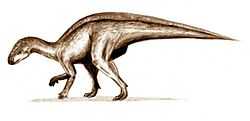Gosau Group
| Gosau Formation Stratigraphic range: Campanian[1] | |
|---|---|
| Type | Stratigraphic Group |
| Location | |
| Country |
|
The Gosau Group is a geological Stratigraphic Group in Lower Austria whose strata date back to the Late Cretaceous.[2] Dinosaur remains are among the fossils that have been recovered from the group.[1]
Vertebrate paleofauna
| Dinosaurs of the Gosau Formation | ||||
|---|---|---|---|---|
| Genus | Species | Presence | Notes | Images |
|
Crataeomus[1] |
C. lepidophorus[1] |
Geographically present in Niederosterreich, Austria.[1] |
Later found to be synonymous with Struthiosaurus austriacus.[1] |
|
|
C. pawlowitschii[1] |
Geographically present in Niederosterreich, Austria.[1] |
Later found to be synonymous with Struthiosaurus austriacus in partim.[1] | ||
|
Danubiosaurus[1] |
D. anceps[1] |
Geographically present in Niederosterreich, Austria.[1] |
Later found to be indeterminate ankylosaurian and Struthiosaurus austriacus remains in partim.[1] "Indeterminate fragments."[3] | |
|
Hoplosaurus[1] |
H. ischyrus[1] |
Geographically present in Niederosterreich, Austria.[1] |
Later found to be synonymous with Struthiosaurus austriacus.[1] | |
|
Leipsanosaurus[1] |
L. noricus[1] |
Geographically present in Niederosterreich, Austria.[1] |
Later found to be synonymous with Struthiosaurus austriacus.[1] | |
|
M. suessi[1] |
Geographically present in Niederosterreich, Austria.[1] |
Later found to be possible Rhabdodon priscus remains.[1] | ||
|
Pleuropeltus[1] |
P. suessie[1] |
Geographically present in Niederosterreich, Austria.[1] |
Later found to be synonymous with Struthiosaurus austriacus in partim.[1] | |
|
?R. priscus[1] |
Geographically present in Niederosterreich, Austria.[1] |
|||
|
R. alcinus[1] |
Geographically present in Niederosterreich, Austria.[1] |
Possible indeterminate ankylosaur remains.[1] | ||
|
S. austriacus[1] |
Geographically present in Niederosterreich, Austria.[1] |
|||
|
M. pannoniensis[1] |
Geographically present in Niederosterreich, Austria.[1] |
Later found to be indeterminate theropod remains.[1] | ||
|
indetermined Ornithocheiridae[4][5] |
||||
See also
References
- ↑ 1.0 1.1 1.2 1.3 1.4 1.5 1.6 1.7 1.8 1.9 1.10 1.11 1.12 1.13 1.14 1.15 1.16 1.17 1.18 1.19 1.20 1.21 1.22 1.23 1.24 1.25 1.26 1.27 1.28 1.29 1.30 1.31 1.32 1.33 1.34 1.35 1.36 1.37 1.38 1.39 1.40 1.41 1.42 Weishampel, David B; et al. (2004). "Dinosaur distribution (Late Cretaceous, Europe)." In: Weishampel, David B.; Dodson, Peter; and Osmólska, Halszka (eds.): The Dinosauria, 2nd, Berkeley: University of California Press. Pp. 588-593. ISBN 0-520-24209-2.
- ↑ McCann, T. (2008). The Geology of Central Europe- Volume 2 Mesozoic and Cenozoic. Bath: Geological Society London. ISBN 978-1862392656.
- ↑ "Table 17.1," in Weishampel, et al. (2004). Page 367.
- ↑ http://epub.ub.uni-muenchen.de/12007/1/zitteliana_2008_b28_05.pdf
- ↑ Federico L. Agnolin and David Varricchio (2012). "Systematic reinterpretation of Piksi barbarulna Varricchio, 2002 from the Two Medicine Formation (Upper Cretaceous) of Western USA (Montana) as a pterosaur rather than a bird". Geodiversitas 34 (4): 883–894.
